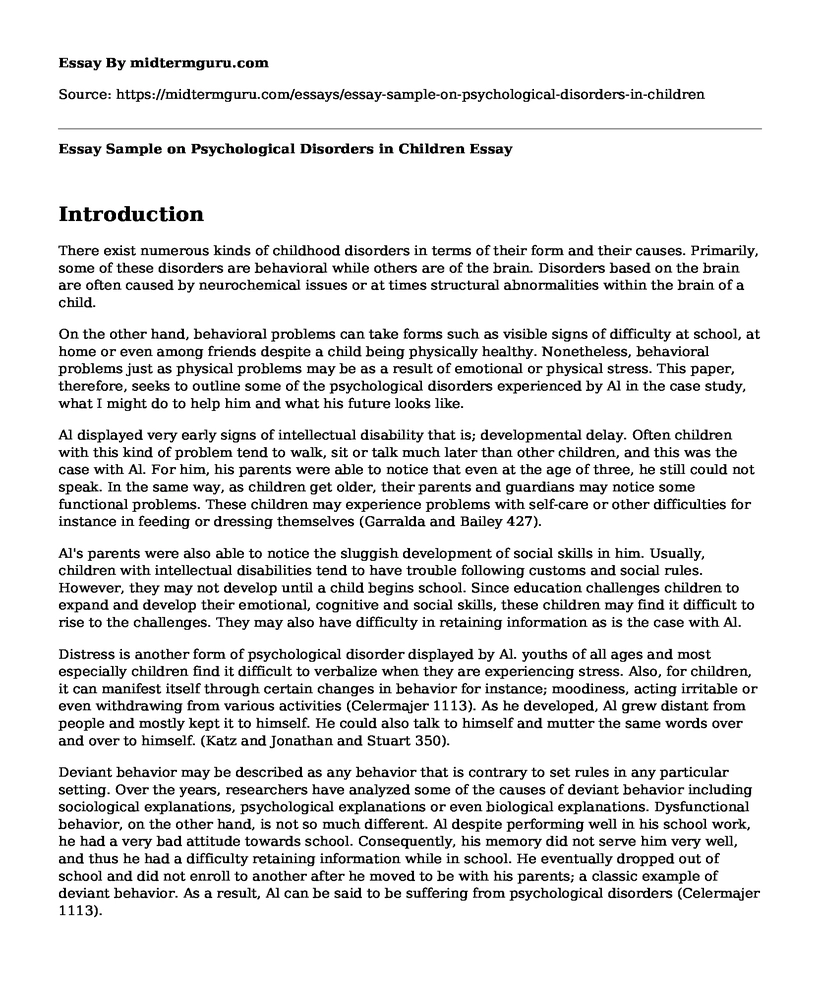Introduction
There exist numerous kinds of childhood disorders in terms of their form and their causes. Primarily, some of these disorders are behavioral while others are of the brain. Disorders based on the brain are often caused by neurochemical issues or at times structural abnormalities within the brain of a child.
On the other hand, behavioral problems can take forms such as visible signs of difficulty at school, at home or even among friends despite a child being physically healthy. Nonetheless, behavioral problems just as physical problems may be as a result of emotional or physical stress. This paper, therefore, seeks to outline some of the psychological disorders experienced by Al in the case study, what I might do to help him and what his future looks like.
Al displayed very early signs of intellectual disability that is; developmental delay. Often children with this kind of problem tend to walk, sit or talk much later than other children, and this was the case with Al. For him, his parents were able to notice that even at the age of three, he still could not speak. In the same way, as children get older, their parents and guardians may notice some functional problems. These children may experience problems with self-care or other difficulties for instance in feeding or dressing themselves (Garralda and Bailey 427).
Al's parents were also able to notice the sluggish development of social skills in him. Usually, children with intellectual disabilities tend to have trouble following customs and social rules. However, they may not develop until a child begins school. Since education challenges children to expand and develop their emotional, cognitive and social skills, these children may find it difficult to rise to the challenges. They may also have difficulty in retaining information as is the case with Al.
Distress is another form of psychological disorder displayed by Al. youths of all ages and most especially children find it difficult to verbalize when they are experiencing stress. Also, for children, it can manifest itself through certain changes in behavior for instance; moodiness, acting irritable or even withdrawing from various activities (Celermajer 1113). As he developed, Al grew distant from people and mostly kept it to himself. He could also talk to himself and mutter the same words over and over to himself. (Katz and Jonathan and Stuart 350).
Deviant behavior may be described as any behavior that is contrary to set rules in any particular setting. Over the years, researchers have analyzed some of the causes of deviant behavior including sociological explanations, psychological explanations or even biological explanations. Dysfunctional behavior, on the other hand, is not so much different. Al despite performing well in his school work, he had a very bad attitude towards school. Consequently, his memory did not serve him very well, and thus he had a difficulty retaining information while in school. He eventually dropped out of school and did not enroll to another after he moved to be with his parents; a classic example of deviant behavior. As a result, Al can be said to be suffering from psychological disorders (Celermajer 1113).
Conclusion
From my perspective, various options and solutions may be adopted to help Al in his situation. For instance, having recognized that he has a psychological disorder, I would find a more exciting way of learning, for instance, find other children with similar issues so that he would not feel as though he is the only one with the problem. This way it would be easier for him to interact with the other children as they would understand each other. Secondly, I would find a well-qualified children therapist who would be able to help him through the loneliness and social dysfunction in general. This way, Al would learn how to open up and talk about his issues without the fear of being judged and laughed at. Thirdly, I would strive to create a peaceful environment for him where he can comfortably interact with the outside world but without having to undergo any emotional or physical pressures such as those that arise from cyberbullying. This way, stigmatization, and the diagnostic label would not play a significant role as he would only interact with people who understand him. In conclusion, therefore, there is a future for Al, and he does not have to live with this condition for a long time as there are several solutions that can be applied to his situation.
Work Cited
Celermajer, David S., et al. "Non-invasive detection of endothelial dysfunction in children and adults at risk of atherosclerosis." The Lancet 340.8828 (1992): 1111-1115.
Garralda, M. E., and D. Bailey. "Psychological deviance in children attending general practice." Psychological medicine 16.2 (1986): 423-429.
Katz, Ernest R., Jonathan Kellerman, and Stuart E. Siegel. "Behavioural distress in children with cancer undergoing medical procedures: developmental considerations." Journal of consulting and clinical psychology 48.3 (1980): 356.
Cite this page
Essay Sample on Psychological Disorders in Children. (2022, Sep 22). Retrieved from https://midtermguru.com/essays/essay-sample-on-psychological-disorders-in-children
If you are the original author of this essay and no longer wish to have it published on the midtermguru.com website, please click below to request its removal:
- Observation on the Level of Communication Between Parents and Children
- Essay Sample on Foreign Language Education
- Essay Sample on Child Language Development
- Early Childhood With Science Ability - Paper Example
- Media's Ubiquitous Presence in Children's Lives: Impact and Transformation - Essay Sample
- Georgetown Summer Sessions - Essay Sample
- Government Intervenes to Support Healthy, Safe Community for Kids - Essay Sample







